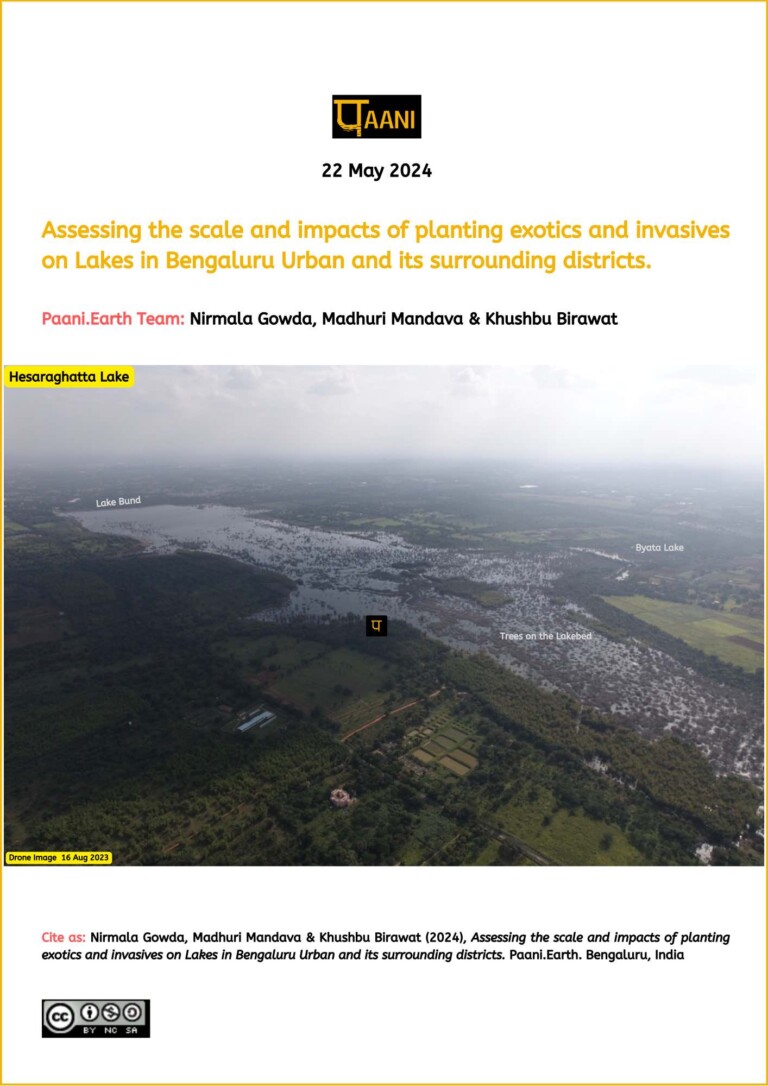Report: Assessing the scale and impacts of planting invasives on Lakes in Bengaluru Urban and its surrounding districts.
Updated Date: 22 May 2024
PROJECT CO-ORDINATOR: Nirmala Gowda (For comments/suggestions write to paaniearth@gmail.com)
Click Image to load the report
Since the 1990s, the Karnataka Forest Department has actively planted exotic and invasive tree species across lakebeds—not just on their peripheries—to prevent encroachment and to harvest fuelwood. Our spatial analysis revealed that nearly half (47%) of the lake area in the Hesaraghatta Lake catchment is covered by trees and shrubs. Data from ESA World Cover 2021 shows that in Bengaluru Urban, 49% of lakebeds are covered with trees and shrubs, with specific areas like Anekal Taluk experiencing even higher coverage at 57%. In some instances, entire lakes have transitioned into forest-type woodlands or tree parks.
Through fieldwork, spatial analysis, research, and discussions with various stakeholders—including limnologists, professors, fishermen, local activists, gram panchayat members, and forest department officials—we explore the consequences of this transformation on water storage, water quality, and aquatic biodiversity. We also delve into the legal ramifications of these practices in light of lake conservation laws and other relevant legal standards.
Excerpts from the report:
Defining The Problem of lakebed plantation
Trees are typically planted around the peripheries of lakes where they serve as riparian buffer zones. In these zones, trees play crucial roles in maintaining lake ecosystem health by filtering pollutants, stabilizing shoreline soils, providing habitat for diverse wildlife, regulating water temperature through shading, maintaining stream channel structures by reducing runoff velocity, and absorbing excess water during heavy rainfall to mitigate flood risks.
However, when trees, especially invasive and exotic species, are extensively planted directly on lakebeds, they pose significant problems. This misplacement transforms lakes—whose primary function is to store water—into woodlands, fundamentally altering their ecological and hydrological functions. This report evaluates the scale and impact of such plantations, underscoring the conversion of functional water reservoirs into wooded areas.
Extent of plantation – Insights from spatial analysis
We utilised the European Space Agency’s Copernicus Sentinel-2 imagery to assess the mature tree coverage across the lakes in the Hesaraghatta Lake catchment of the Arkavathi River Basin. Using supervised classification techniques, we estimated that approximately 2,917 acres out of the total 11,961 acres of lake area were covered with vegetation, representing 24% of the lake area as of 2023.
Upon reviewing Google Earth’s historical images, we noticed saplings planted in neat rows. However, the absence of mature trees in these areas indicated that a large portion of the saplings did not survive. This was corroborated by local reports during our field surveys, which also suggested that some saplings might have been harvested. We marked all areas with visible neat rows of planting from the Google Earth imagery. The area of neat rows were then integrated with the 2023 tree and shrub cover data. The results showed that approximately 47% of the lake area in the Hesaraghatta catchment has been affected by plantation activities as of 2023.
Further application of the ESA dataset to other regions around Bengaluru provided these insights:
- Bengaluru Urban: 49% of lake areas are covered with trees and shrubs, with Anekal Taluk showing an even higher coverage at 57%.
- Bengaluru Rural: 40% of lake areas consist of tree and shrub cover.
- Chikkaballapura: 35% of lake areas have tree and shrub coverage.
- Kolar District: 38% of lake areas feature tree and shrub coverage.
- Tumakuru District: Tree and shrub cover accounts for 38% of lake areas in this district.
These findings illustrate the magnitude of trees and shrubs on the lakebed, raising serious concerns about the impact on the lake ecosystem.
Implications for water availability
Farmers in Chikkballapura, particularly around Sidlaghatta Lake, support the removal of trees from lakebeds, so it could store water and recharge groundwater, said Anjaneya Reddy. Farmers’ concern was discussed in the Karnataka Legislative Assembly in 2018. The Speaker, KR Ramesh Kumar, controversially advocated for local farmers to take direct action to remove water-intensive trees like mesquite (Prosopis juliflora) and eucalyptus, which he described as detrimental to water bodies. This stance was supported by various legislators, including BJP’s JC Madhuswamy, who criticised the forest department’s practices.
Dr Harini Nagendra recalls a visit to Mestripalya and Kasavanahalli lakes with members of the Central Ground Water Board (CGWB), during which the CGWB explicitly recommended clearing these exotic and invasive trees from lakebeds due to their impact on groundwater availability.
Ironically, while the government plans to cut down an enormous number of trees and submerge 5,500 hectares of the Cauvery Wildlife Sanctuary to facilitate water storage at Mekedatu, it is also transforming lakes designated for water storage into forest-type woodlands here in Bengaluru and its surrounding areas. This is a classic example of the government’s conflicting approach to managing water and forests, where the urgent need to conserve water conflicts with the efforts to increase terrestrial green cover that could provide much-needed wood, even if it is with exotics and invasives.
Are trees encroaching on lakes ?
The Karnataka Tank Conservation and Development Authority (KTCDA) Act was implemented to manage and conserve tanks and lakes. Section 12 of the Act lists prohibited activities on lakes, stating that using a tank for any purpose other than the storage or impounding of water or to improve/create habitat for aquatic biodiversity, water birds, and aquatic plants is prohibited. It is our interpretation that the nature and magnitude of tree plantations intended for fuelwood (as the Forest Department issues tenders to harvest this fuelwood) interferes with water storage, thus constituting an encroachment.
Conclusion
While trees are often beneficial to many environments, their placement in lakes needs careful consideration.
Lakes primarily function as water reservoirs, and while converting them into forested areas seems beneficial for terrestrial wildlife, it can compromise their ability to store water. Forests & trees are indeed under threat, but so are lakes. For instance, Bengaluru city has experienced a 79% reduction in lake area over the past four decades.
Experts like Harini Nagendra suggest stopping further tree planting on lakebeds and starting the removal of non-native, large trees such as eucalyptus, followed by Acacia auriculiformis and silver oak. Anjaneya Reddy and Chidanandamurthy emphasise the necessity of removing invasive species like Prosopis juliflora (mesquite) and Acacia nilotica (Karijali).
To safeguard the lakes effectively, new tree plantations should cease, and efforts to control invasive species should be increased. Trees should be restricted to the catchment areas and peripheries, not the lakebeds themselves. Collaborative efforts among stakeholders, including the Minor Irrigation Department, local panchayats, and citizens, are crucial to rectify the consequences of past inappropriate planting practices by the forest department.

RIVER BASIN

DAMS & FLOW

POLLUTION

GROUNDWATER

STRAWS

BIODIVERSITY

RAINFALL FLOODS & DROUGHT

RESTORATION









